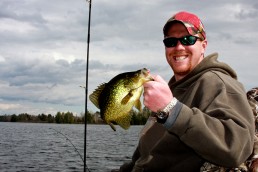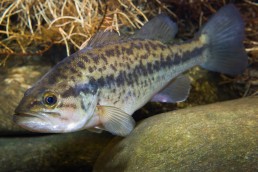Fox Chain Report
SHARE THIS POST
April on the Fox Chain is a “crappie month.” This species will infiltrate the shallow bays, channels and backwaters in high numbers to feed, and then return for the spawn. Now is the time for some hot crappie action.
For equipment, go ultra-light for the most fun and consistent catching. Use 4- to 7-foot spinning rods or 12- to 20-foot cane poles or the fiberglass models. For line monofilament, it’s still best to use 4-pound-test. Crappies are very line-sensitive, so the lighter the better. If you’re adventurous, you can go down to 2-pound-test line, but you will stand the risk of losing a bigger fish. You don’t need 8-pound-test and not even 6, as the 4-pound-test line will get you the most bites and still land decent-sized fish. Set your drag light and play the larger fish. You will catch occasional bass, catfish, walleyes, and even a pike or muskie while fishing for crappies.
When searching for crappies, a casting approach is the best way to cover water and locate the active fish. Some good casting baits are Beetle Spins, Blakemore Road Runners, a small jig and twister tail or even a small tube jig. Once the active fish are found it’s a great time to break out the bobbers or floats, quietly lower an anchor and catch a bunch. Floats made by Thill are sensitive, and in shallower water where the majority of crappies are found, a fixed float is all you need. When fish are located in deeper water a slip bobber or float will work better.
For fixed floats, great choices are the Shy Bite and Super Shy Bite floats and come in a couple different sizes. Choose the proper size that will hold up the weight of the bait you’re using without sinking. Some favorite baits to use are Cubby Mini-mites, Custom Jig and Spins Shrimpos, Ratsos and Ratfinkees baited with a waxworm or a small minnow. Tube jigs and small ice-fishing jigs are all great choices too.
Cast your presentation alongside piers, seawalls and around fallen timber. Warmer water temperatures are key and wood in the water will help to warm it in areas; metal should be avoided until the water temperatures increase.
There are many places that will hold early-spring crappies. Channel Lake, Robbie’s Channel, Lake Street Channel and the L-Channel, as well as the north-end and south-end bays, will all hold fish. The north end will warm first, and later in the month the south end will turn on. The temperature gauge on your boat is an important tool for the early season. Lake Marie, the Sequoit Creek and T-Channel are early crappie producers. There are lots of channels throughout the Chain that are crappie hot spots too including Ackerman’s Channel and Squaw Creek off of Fox Lake and the T-Channel on Pistakee Lake.
Catching 50 to over 100 of this species is quite common now. Please just keep enough for a great meal and release the rest. If you catch fish over 12 inches, I recommend releasing them, as this will ensure good fishing for years to come.
Are you enjoying this post?
You can be among the first to get the latest info on where to go, what to use and how to use it!
Walleyes
Walleye fishing is very good throughout April as fish are shallow and spawning. Pitching jigs to the shallows is a very fun and effective technique, while casting shallow-running crankbaits like small Husky Jerks, Rapala Shad Raps and Berkley Flicker Shads work too. For jigs, a lightweight hair jig, twister tail or plain jig and live fathead minnow will do the trick.
Search out shallow gravel flats, points and hard-bottom areas around the numerous islands that attract spawning walleyes. Lake Marie, Fox Lake and Pistakee Lake have good areas for spawning walleyes. Another technique is drifting over the shallow flats with live-bait rigs. A hook and split shot or a spinner rig with a minnow can be deadly. Lindy Little Joe also has come out with a new live-bait rig, “Little Guy.” This is a harness with a crankbait-style head that wobbles when pulled through the water.
The third presentation for walleyes is through trolling crankbaits. You can use planer boards to run baits into the extreme shallows or you can flat-line them. Often, the shallower Chain walleyes are unaffected by the presence of your boat. Flat lining allows you to follow the sharp contours with precision.
Some recommended baits for trolling include small number 7 or 9 Original Floating Rapalas, small 6 and 8 Husky Jerks, Salmo Hornet’s, Berkley Flicker Shads, Rapala Shad Raps, Wally Divers and Storm Smash Shads. Just stick with the smaller sizes in spring.
Largemouth fishing starts getting good as the water warms. Fish will start moving into shallow bays, channels and creeks, looking to feed prior to the spawn. Most lakes have good largemouth fishing, and the dark-water lakes of the southern parts of the Chain will warm up first followed by the clearer northern lakes. Wherever you decide to fish, concentrate on the north side of the lake and find the warmest water available. A tandem spin and spinnerbait is a great tool to search for the active bass. A white or white and chartreuse spinnerbait with dual Colorado blades are good in the darker waters as they put out a great vibration to attract bass. ChatterBaits are also effective. This blade swimbait puts out a lot of vibration that attracts bass in cooler water. When some are located, rework the area with a slow presentation with a jig and craw, a tube jig or small 4-inch finesse worm. When the water in the back channels get up into the low 60s, the male bass start looking to make beds for the annual spawning ritual. On the Chain, spawn can sometimes last from 4 to 6 weeks, with shallow, dark-water lakes and the deeper, clear-water lakes where fish will spawn last. Again, your temperature gauge can clue you in as to when this will happen.
The Chain is beginning to heat up and now is the time for the fisherman, before all the pleasure boaters arrive.
MWO
SHARE THIS POST
You may also like...
Did you enjoy this post?
You can be among the first to get the latest info on where to go, what to use and how to use it!
Phil Piscitello
Phil Piscitello has 45 years of experience as a multispecies angler on ice and open water. He is a fishing guide, master charter captain and seminar speaker guiding in northern Illinois and southern Wisconsin. Picitello is also a regular guest on Chauncey’s Great Outdoors radio show and MidWest Outdoors TV show. He has fished all five Great Lakes and many major rivers, lakes, and reservoirs throughout the Midwest.


